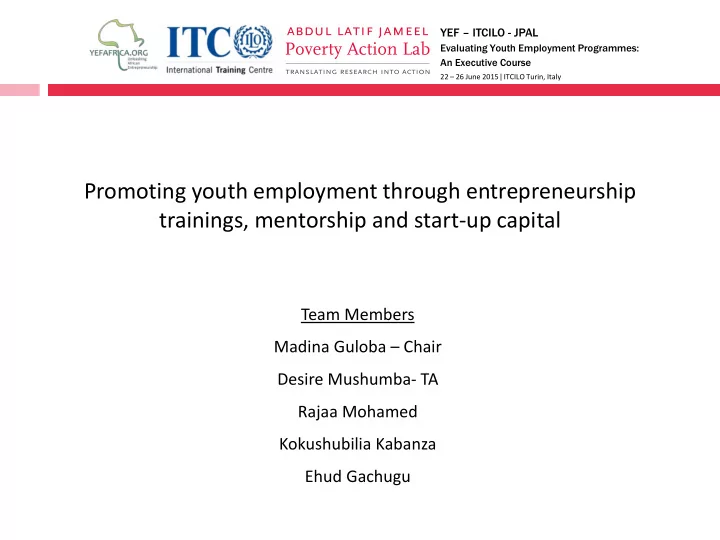

YEF – ITCILO - JPAL Evaluating Youth Employment Programmes: An Executive Course 22 – 26 June 2015 ǀ ITCILO Turin, Italy Promoting youth employment through entrepreneurship trainings, mentorship and start-up capital Team Members Madina Guloba – Chair Desire Mushumba- TA Rajaa Mohamed Kokushubilia Kabanza Ehud Gachugu
Background • Youth employment situation remains one of the key challenges in Tanzania. • Unemployment rate among youth - 15 and 34 years old stands at 13.4 per cent ; females stand at 14.3 per cent and amongst males were 12.3 per cent. • Urban areas are hardest hit with unemployment rate, reaching 22.3 per cent as against 7.1 per cent in the rural areas. • WB Study - Every year it is estimated that over 800,000 young men and women enter the labour market . • These include school and college graduates and people who have migrated from rural areas to urban areas
Program specific context - it is estimated each year 700,000 graduates entering the labour market but only 40,000 (5.7%) get employment into formal sector - Employers tend to omit the inexperienced youths mainly fresh graduates in the presence of readily available jobs and experienced adults. - Many initiatives have been introduced by the government to create job opportunities to the youth graduating from different universities - Very limited formal employment opportunities from public and private sector creating a huge opportunity for self employment
….Program specific context - The overall objective of the project is to improve graduate youth employment in Tanzania - The project will aim at provision of entrepreneurship trainings, mentorship and startup capital to University graduates in Daresalam - The eligible graduates will be aged between 18 – 35, not working or running a business, not in training or school and have at least 2 years after graduation - The project will target graduates from both public and private universities situated at Daresalam.
Theory of change Need Most graduates unable to develop proper business plans, lacks guidance and capital to start the business. Assessment • Entrepreneurship Trainings Intervention • Start up capital • Mentorship and couching Assumptions • Gradates willing to start businesses rather than formal jobs • Private sector willing to support the program without any direct incentive. • Increased graduate youth-led enterprises Intermediary outcomes Outcomes Increased youth employment 5
Evaluation Questions and Outcomes • Does training, mentorship and start-up capital increase graduate employment though entrepreneurship? • Does the intervention improve graduate skills in entrepreneurship? • Specific outcomes of interest is increase in self-employment among graduates • Specific indicators Existence of an enterprise Existence of business for at least 1 year Existence of business for more than an year and profitable
Evaluation Design • Individual university gradates in public and private universities at Daresalam. • A call for application to graduates who studied in all universities in Dar and not working. • A list of eligible applicants will be developed. • A treatment and control group will be randomly selected from the eligible applicants • Stratification variables – Gender, type of university (public or private) and degree type (arts or science)
Data and Sample Size • key outcome of interest: Increased graduate Employment in Tanzania • Secondary data from existing studies and responsible government ministries and agencies • Primary data will be in two waves; • Baseline survey • End line survey
Data and Sample Size Power calculations • Mean from Baseline is 10% • Standard deviation = 0.3 • Effect size =0.07 • Sample size = 6,390 • Assuming balance • Treatment = 6,390/2 = 3,195 • Control = 6,390/2 = 3,195
Data and Sample Size
Potential challenges • Possible non compliance -incomplete take up • Attrition – This is likely to be particularly high among control group • Contamination – Because both group are within same town
Potential challenges • Possible non compliance -incomplete take up • Attrition – This is likely to be particularly high among control group • Contamination – Because both group are within same town
Attrition • Low take up: we may check if there are characteristics of the post test and conclude on their influence on the outcomes • Drop out: Attending other more attractive programs. Analyze characteristics before ( Intend to be treated ) and at the end of the intervention.
Results • The results of this study will be useful in three key areas • Theory - Add to existing knowledge on this subject • Policy – Support evidence based policy development • Practice - Inform program implementation • Dissemination: Meeting with policy makers and publications
Thank you for listening
Recommend
More recommend